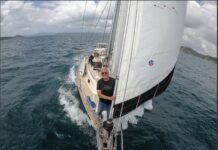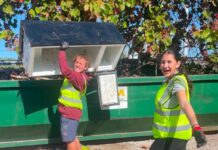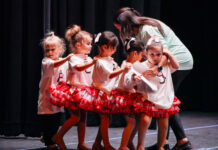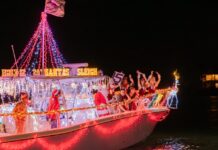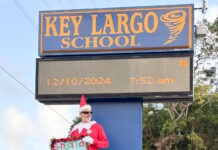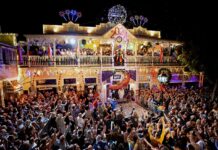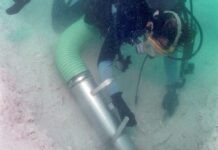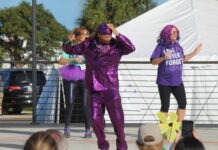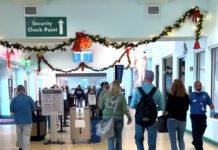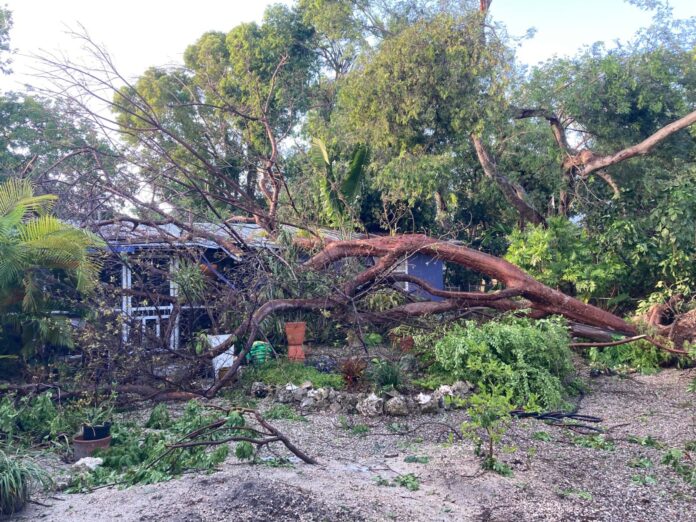
We have a small concrete house on Plantation Key. When we bought it in 2012, we first fell in love with the front yard’s trees and the shade and privacy they afforded. Inside, the two-bedroom, one-bath house has an open floor plan. Our couch rests against the far coral-colored wall.
On a recent Sunday, at about 11 p.m., I was on the couch watching the new season of “Cobra Kai.” The show follows the lives of the Karate Kid and his foe, Daniel LaRusso, played by the barely-aging Ralph Macchio. Sometimes, when I am on the couch watching television at night, fireflies light up as they fly between the green buttonwoods outside and the window above the sofa.
That Sunday night, lightning flashed through the window like great crackling sheets once, twice, three times. I heard rain falling and was happy that the yard was getting real water. And then there was this rumble. When I looked up at the window, the lightning flashed again, and tropical forces were blowing through the buttonwood trees. The rumble got louder, the lights flickered, and some other louder noise that I did not recognize reverberated through the house.
I sat up straight on the couch, grabbed the arm, and the television went dark. Everything went dark. The lack of power turned everything off but the brief roar of the wind raging outside. As suddenly as it came down, it vanished. I walked to my desk, picked up my phone, and slipped my feet into the Kino sandals. I don’t know what I expected to see when I opened the front door. I did not expect to see a roof panel on the concrete patio floor, cracked timbers overhead, and a large gumbo tree lying outside with one of its old, thick, sunburned limbs crushing the roof.
The gumbo limbo is sometimes referred to as the tourist tree because its reddish, flaking bark lends the appearance of peeling skin. The tree obstructed the egress. Before slipping out the back door, I checked on Michelle, the dog and the cat. I wanted to know what had happened. By 11:30, all the neighbors were standing in the street, pointing flashlight beams around, trying to make sense of what had just happened.
“Was it a tornado?”
“I think it was a tornado.”
The isolated damage it left behind was certainly tornadoesque. Alas, the professionals called it a microburst, not a tornado. Microbursts develop within a storm system and materialize as a localized column of sinking air, a downdraft that strikes the ground, producing straight-line winds that can exceed 100 mph.
Microbursts are dangerous and can be equated with up to an EF 1 tornado. Tornadoes are rated much like hurricanes. Whereas hurricanes are categorized according to the Saffir-Simpson Hurricane Wind Scale, tornadoes are rated on the Enhanced Fujita Scale, which ranges from an EF 0 (65-85 mph winds) to an EF 5 (over 200 mph winds). One of the big differences between a tornado and a microburst is that the winds swirl in a tornado and do not in a microburst.
Tornadoes are assigned their scale based on the wind speed and damage caused by the event. Meteorologists estimated that the sudden downdraft that blew through our neighborhood had winds in the 65- to 85-mph range, or those associated with an EF 0 tornado. Whatever arrived that late Sunday night was over and done within a matter of minutes. And then, the community love came pouring out.
By 11:45 p.m., chainsaws were buzzing and slicing away at the thick branches of the old- growth ficus that had sheared away in the meteorological event and were now blocking the street. A Bobcat was moving pieces of tree trunks to the side of the street. After the sun rose Monday morning, Sioux Street again filled with neighbors as cars and trucks filed past, slowing down to look closer, and golf carts — a lot of neighborhood golf carts.
You can say a lot of things about the Florida Keys, but you cannot deny its sense of community. It was on full display Monday and Tuesday as people showed up with chainsaws and gloves fitted to helping hands – and pizza. A young man from the neighborhood rode up on a bicycle with a chainsaw in its basket. He stopped, put his foot on the kickstand, and, with a pull, brought the chainsaw to life. But that is just what happens when things become unfortunate, go wrong, or something devastating unfolds. The people of the Florida Keys pull together.
From down the street, Jerry came rumbling with his Bobcat, and as he worked, the piles of tree trunks and limbs grew bigger and higher. When professional landscapers arrived to cut through the biggest trees, the piles grew longer and higher still. For our little house, the damage far exceeded what we experienced in 2017’s Hurricane Irma.
Most of our beautiful trees are gone, and along with them, our sense of privacy. In time, the yard will recover and will be replanted with sun-loving plants that will grow, and the yard will begin to resemble the one we fell in love with in 2012. Of course, the tropics are just heating up, and August and September are just around the corner. Hopefully, this is the last hit we take this season. If not, we have been reassured by the scale of community love the Florida Keys keeps in its collective tank.
